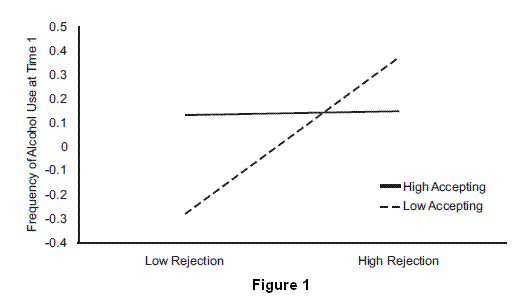STASH, Vol. 5(5) – Substance use and abuse among lesbian, gay, and bisexual youths: The role of rejection to disclosure
Youths who self-identify as lesbian, gay, or bisexual (LGB) are significantly more likely than other young people to report using alcohol, tobacco, and other drugs (Marshal et al., 2008). Recent research has focused on risk or protective factors that influence substance use among this population. One proposed risk factor is rejection from one’s friends and family members following the disclosure of sexual orientation (i.e., “coming out”). Rejection following disclosure might produce feelings of shame and social isolation, which might contribute to increased substance use. This week’s STASH reviews a recent study of the relationship between reactions to disclosure of sexual orientation and substance use among LGB youths (Rosario, Schrimshaw, & Hunter, 2009)
Participants
• Participants were an ethnically diverse convenience sample of 156 14-21 year-olds (mean age = 18.3, SD = 1.65) recruited from LGB community-based and college student organizations in New York City.
• Roughly 66% self-identified as lesbian/gay, 31% identified as bisexual, and 3% identified as “other” (e.g., “confused”).
Procedures
• Participants completed a 2- to 3-hour structured interview at recruitment (Time 1), with follow-up interviews occurring 6 and 12 months later (Times 2 and 3, respectively).
• The retention rates were 92% for the 6-month assessment and 90% for the 12-month assessment.
• Attrition analyses revealed that participants lost to one or more follow-up assessments did not differ at baseline from those interviewed at all three assessments on any demographic factors or Time 1 variables.
• Participants were paid $30 at each interview.
Primary Measures
• Participants listed the “important people” to whom they first disclosed their sexual orientation and then indicated whether each person reacted in an accepting, neutral, or rejecting manner. Therefore, there were four disclosure measures: the total number of people, and the number of people who had an accepting, neutral, or rejecting response.
• Substance use (quantity and frequency of cigarette, alcohol, and marijuana use) was assessed at Times 1-3 using the Alcohol and Drugs Schedule (see Rosario, Schrimshaw, & Hunter, 2009). The Time 1 assessment measured substance use in the past 3 months; the Times 2 and 3 assessments measured substance use in the past 6 months. Investigators assessed substance abuse using 11 items derived from the Diagnostic Interview Schedule for Children (e.g., “Felt you needed or were dependent on alcohol and/or drugs”). The index of substance abuse was the number of endorsed items.
Results
• On average, participants first became aware of their sexual orientation at age 10 and first disclosed their sexual orientation at age 15. The majority (57.1%) first disclosed to a friend. Approximately 30% first disclosed to a family member. The typical participant’s first disclosure happened roughly 3 years before Time 1.
• Correlations and linear regressions controlling for gender, age, and social desirability revealed that, of the four disclosure measures, only the number of rejecting reactions was directly associated with substance use or abuse. More rejecting reactions predicted greater substance use at Times 1 and 2 (beta’s ranged from 0.13-0.28) and more substance abuse symptoms at Time 2 (beta = 0.44) and Time 3 (beta = 0.20).
• Researchers used linear regression to assess whether the number of accepting reactions moderated the relationship between the number of rejecting reactions and substance use. The interaction term (number of accepting reactions x number of rejecting reactions) significantly added to the prediction of four measures of alcohol use. Inspection of the regression slopes revealed that when participants had fewer accepting reactions, alcohol frequency and quantity increased as the number of rejecting reactions increased. However, when participants had a high number of accepting reactions, participants reported a relatively low/moderate level of alcohol use, regardless of the number of rejecting reactions they experienced. Figure 1, adapted from Rosario et al., 2009, shows the interaction between accepting and rejecting reactions predicting frequency of alcohol use at Time 1. The pattern was similar for other alcohol measures.

Limitations
• The sample was composed of individuals living in an urban environment who were members of LGB organizations. Therefore, this sample might differ from the wider population of LGB youths in some important ways.
• Participants provided descriptions of their disclosure retrospectively.
• Participants varied in the length of time between disclosure and Time 1; it is unclear whether this variable influenced the relationship between reactions to disclosure and substance use/abuse.
• Because these data were correlational, it is premature to conclude that reactions to disclosure causally influenced substance use and abuse.
Conclusions
• Despite the limitations noted above, these data suggest that one risk factor for substance use and abuse among LGB youths is having more friends, family members, and other people react to disclosure in a rejecting manner.
• Accepting reactions to disclosure are protective and blunt the impact of rejection on substance use and abuse.
What do you think? Please use the comment link below to provide feedback on this article.
References
Marshal, M. P., Friedman, M. S., Stall, R., King, K. M., Miles, J., Gold, M. A., et al. (2008). Sexual orientation and adolescent substance use: A meta-analysis and methodological review. Addiction, 103(4), 546-556.
Rosario, M., Schrimshaw, E. W., & Hunter, J. (2009). Disclosure of sexual orientation and subsequent substance use and abuse among lesbian, gay, and bisexual youths: Critical role of disclosure reactions. Psychology of Addictive Behaviors, 23(1), 175-184.